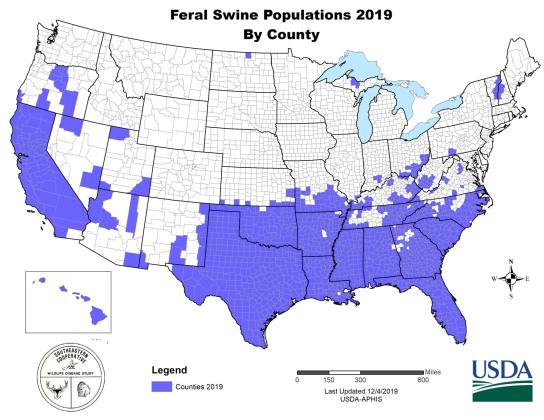Last week I was out on a friend’s ranch in the Hill Country and we were after pigs. I love hunting pigs; they are not nearly as stupid as a lot of folks think. For the most part they don’t come out until right at last light. So, one day last week I set up on a bass tank to see what would show up. Didn’t see a thing until the very last bit of light. A totally white hog showed and she didn’t leave. My 6.5 Creedmoor rifle put her down instantly with about a 100-yard shot in the head. Pigs galore. Now you see them. Now you don’t. But right about now some ranchers in Central Texas are seeing lots of pigs throughout the day. That’s very unusual.
“I’ve been pig hunting out here in Burnett County for over 25 years,” said Cody Bell III. “I can say for sure that I’ve never seen so many roaming around our ranch during daylight hours.”
Wild hogs are difficult animals to figure out when you are in the hunt for them. They can show up just about anytime day or night.
On a recent run to his ranch Bell was stunned at what he saw – pigs galore.
“One thing I’ve learned is that they are totally unpredictable,” he said. “My best hunts are usually at night. But at times we’ll see them during daylight hours, especially at sunset. But during the past couple of weeks we have been seeing a lot of pigs throughout the day.”
Last week he was running along one of the ranch roads, heading back to the camp house, and had nine pigs trot out of the brush, go through a hole in the fence, then turn around a look at him. “Pigs are notoriously spooky, but those were not in the least bit scared,” said Bell. “It’s as if they knew I didn’t have a gun.”
Heath Lusty is an agricultural extension agent in Lampasas. He said that one reason for seeing pigs during the day is that they have more food resources.
“Rain will get them to moving and rooting around the soft soil during the day,” he said. “Pigs will feed on anything from plants to varmints. Right now, while it’s still cool, they will be moving and feeding throughout the day. They especially like to eat fresh seeds that are being planted by farmers. When it’s dry pigs will retreat to the creek beds and drainages for protection. But when it rains the high water can push them out. And all that soft wet soil makes it easy to find fresh plants and roots.”
Unlike deer, pigs do not have any certain time of year to breed. Deer will typically go into the rut in November and December. That’s when they are easy targets for hunters. Lusty said pigs will breed at just about any time and can have around three litters per year.
On the Independence Ranch in Central Texas a ranch hand named George (didn’t want to give us his last name) said they have over three miles of ranch land that is infested with pigs.
“Rain is the one thing that will flush them out of the dense creek bottoms and thickets,” he said. “They will root around for insects, plant roots and also eat a lot of rats moving away from the rising water. With a little bit of rain, the availability of food increases a lot. That’s when you can actually hunt them during daylight hours with good success rates. But as it gets hotter pigs will become almost totally nocturnal. Something else to consider right now is the lack of hunting pressure. With fewer people moving around a ranch pigs will become a lot less spooky.”
Pig facts
Feral hogs generally travel in family groups called sounders, comprised normally of two sows and their young. Mature boars are usually solitary, only joining a herd to breed.
They can adapt to locations where there is sufficient food, water and cover, but prefer bottomlands. They are attracted to protected, forested areas with water-ways to provide easy travel routes.
Wild pigs are omnivorous, eating both plant and animal foods. Acorns and other nuts are favorites. They will root through the soil for tasty plant roots, bulbs and insects. Small animals, bird eggs and young livestock are also food sources.


